gwpols
GW polarization parameterizations and corresponding Jacobians.
Gravitational-wave polarizations
Like electromagnetic waves, gravitational waves (GWs) in general relativity (GR) come in two distinct polarization states. These can be parametrized in a number of ways—we illustrate a few examples below.
This page contains a summary of the detailed treatment in the review, Parametrizing gravitational wave polarizations (Max Isi, 2022), and complements it with animated versions of Figures 2 and 4.1
The linear basis
GW polarizations are usually represented in the linear polarization basis of plus (\(+\)) and cross (\(\times\)) states, which are typically illustrated by their instantaneous effect on a freely-falling ring of particles, as shown below.
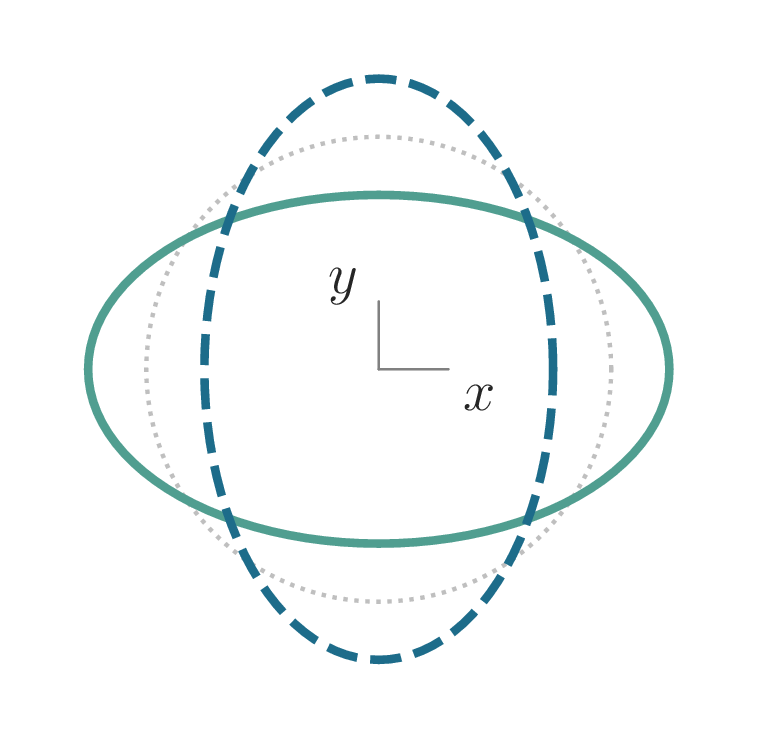
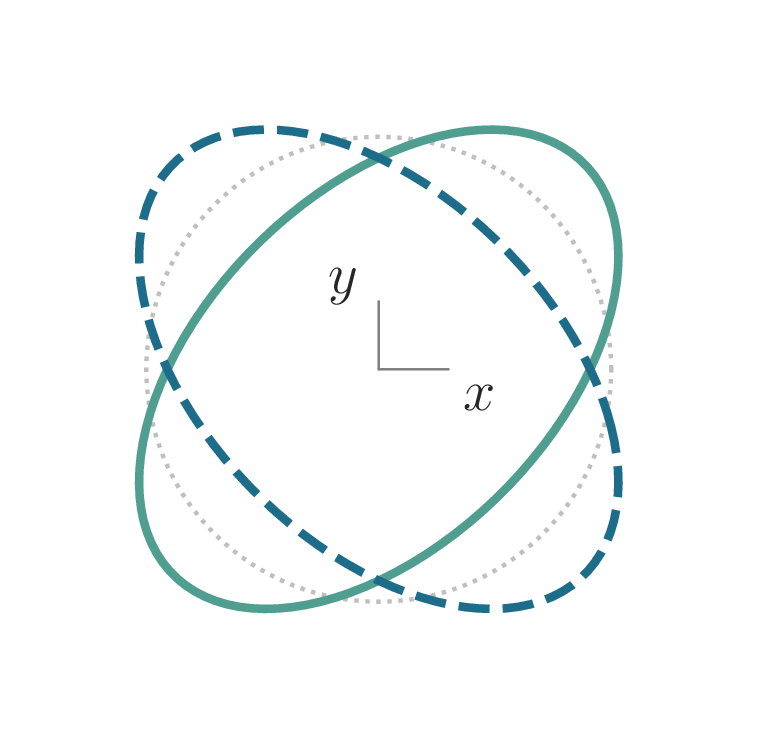
In these diagrams, the GW propagates in the z direction, in or out of the screen, deforming the original ring (dotted circle) into ellipsoidal patterns shown at half-period intervals (solid and dashed).
In GR, any GW can be expressed as a superposition of these two polarization states, and can be specified through time-dependent strain functions \(h_+\) and \(h_\times\). These functions determine the signal observed at any given detector; for any specific source, they are prescribed by Einstein’s equations and relevant initial conditions.
We can visualize how any GW can be decomposed into \(+\) and \(\times\) contributions by explicitly splitting the two polarizations and illustrating their physical effects separately, as in the first figrue above. More abstractly, we can also represent the GW polarization state at any instant through a vector in a Cartesian space defined by the \(\left(h_+, h_\times\right)\) amplitudes: the magnitude of this phasor encodes the overall strength of the signal, and its orientation the ratio between \(+\) and \(\times\).
If the wave is monochromatic (i.e., it has a definite frequency \(\omega\)), we can further represent the individual phases of each polarization component through so-called linear quadratures, \(x_{+/\times}(t) \equiv A_{+/\times} \cos \phi_{+/\times} \cos \omega t\) and \(y_{+/\times}(t) \equiv A_{+/\times} \sin \phi_{+/\times} \sin \omega t\) (these are just a convenient way of representing an arbitrary sinusoid). The figure below shows an example of all these representations for the simple case of a fully \(+\)-polarized wave.
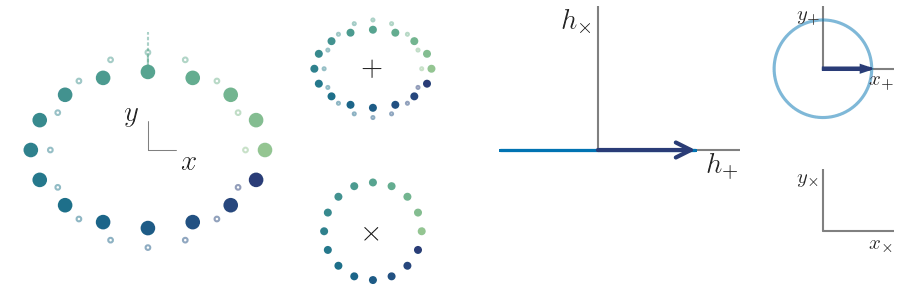
There is a lot going on in this figure. First, the leftmost diagram shows the overall effect this wave on a freely-falling ring of particles, similar to the diagram above. Next to it, center left, we show the decomposition of this effect into the \(+\) (top) and \(\times\) contributions; in this case, there is no \(\times\) contribution because this is a pure \(+\) wave. Next, center right, we have the instantaneous polarization state, as represented by a phasor in the \(h_+\) vs \(h_\times\): the arrow represents the amplitude of plus vs cross waves at any given instant; in this case, we only have \(+\) waves, so the arrow moves horizontally back and forth. Finally, the rightmost diagram shows the decomposition into the cosine and sine quadratures for \(+\) (top) and \(\times\) (bottom), and you will notice that only the former evolves in this case.
We can do the same for a pure \(\times\) wave. This time setting \(h_+ = 0\) we obtain the following.
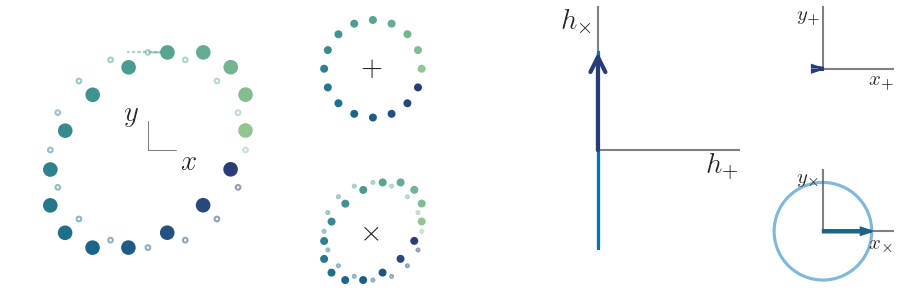
Now only the \(\times\) quantities evolve, and all the \(+\) quantities vanish. A general GW will be made up of a superposition of plus and cross waves.
The circular basis
For monochromatic GWs, just as in the case of electromagnetic waves, we can also define a circular polarization basis, composed of right and left handed modes. These are defined such that they result in a polarization phasor that rotates around a circle in the \(\left(h_+, h_\times\right)\) plane: if the rotation is counterclockwise (clockwise), we say the state is right-handed (left-handed).
In terms of the linear polarization amplitudes, the corresponding right (R) and left (L) handed polarization amplitudes, \(h_{R/L}\), are given by
\[h_{R/L} = \frac{1}{\sqrt{2}} \left( h_+ \mp i h_\times \right)\]with the minus (plus) sign for R (L). Like we did for the linear polarizations above, the effect of a circular R-polarized GW is illustrated in the animation below.
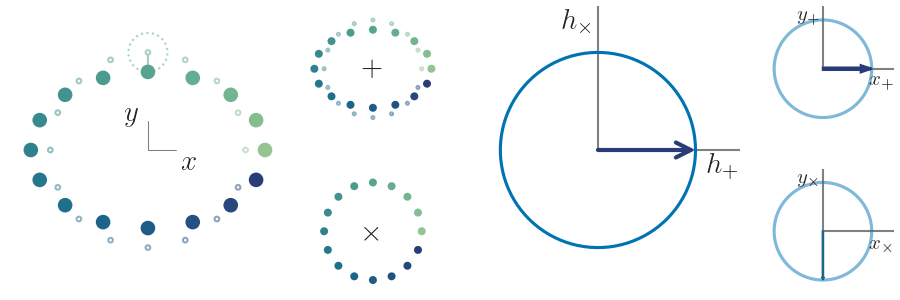
We see that contributions from both \(+\) and \(\times\) components are required to produced a circularly polarized state, and the two linear components must be exactly \(\pi/2\) radians in phase apart in order to add up to a circle.
Just as the circular polarization states define a circle in the \(\left(h_+, h_\times\right)\) plane, they also cause test particles to oscillate in a circle around their equilibrium positions. You can see this in the small circle shown on the left-most panel of the above figure.
A left-handed wave looks the same as above, but with the sense of rotation reversed.
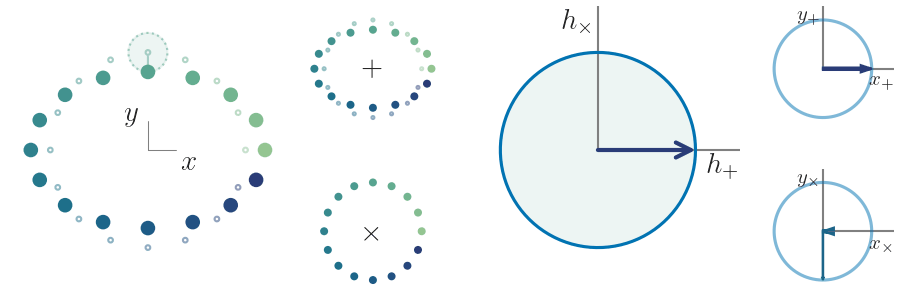
The fact that reversing time turns \(R\) into \(L\) and viceversa tells us that these are eigenstates of the parity operator.
Any monochromatic GW can be decomposed into right and left handed modes. They are more convenient than the linear modes because they are invariant under rotations around the direction of propagation, so there is no ambiguity in how they are defined.
The elliptical basis
Most generally, any fully-polarized GW can be written as a superposition of circularly-polarized modes. If we add up two monochromatic R and L modes of the same frequency but with arbitrary amplitude and phase we obtain not another circular mode but a more general elliptical mode.
Elliptical modes are a natural generalization of both linear and circular modes described above. Rather than defining a line or a circle in the \((h_+,h_\times)\) phasor space, they describe an ellipse, as their name suggests. We illustrate this in the animation below.
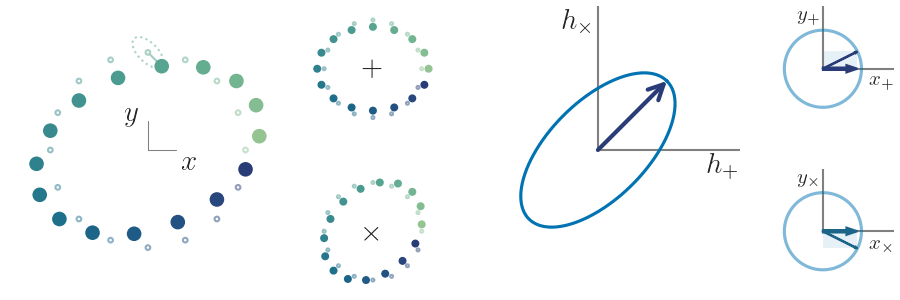
This animation reveals a nice set of features of elliptical modes. First, freely falling rings of particles are also squeezed into an ellipsoidal pattern that rotates at the frequency of the mode; as before, individual points will also follow ellipsoidal trajectories around their initial locations. Remarkable, these ellipses match the ellipse defined in the phasor space, so that each individual points directly reflects the polarization structure of the wave.
Elliptical modes are very useful in practical applications since they provide a generic, well-motivated basis into which to decompose data from GW detectors like LIGO, Virgo and KAGRA.
The 22 mode
Many typicall sources have well defined polarization states that can be described by an elliptical template; this is the case for most sources that radiate in the dominant \(\ell= \pm m =2\) angular mode of the radiation.
For instance, compact binary coalescences (e.g., two inspiralling black holes or neutron stars) will radiately predominantly right-handed GWs when observed from the north pole (the direction of orbital angular momentum), left-handed GWs when observed from the south pole, linearly polarized waves when seen from the equator, and intermediate elliptical polarizations when seen from anywhere else.
We demonstrate this in the animation below.
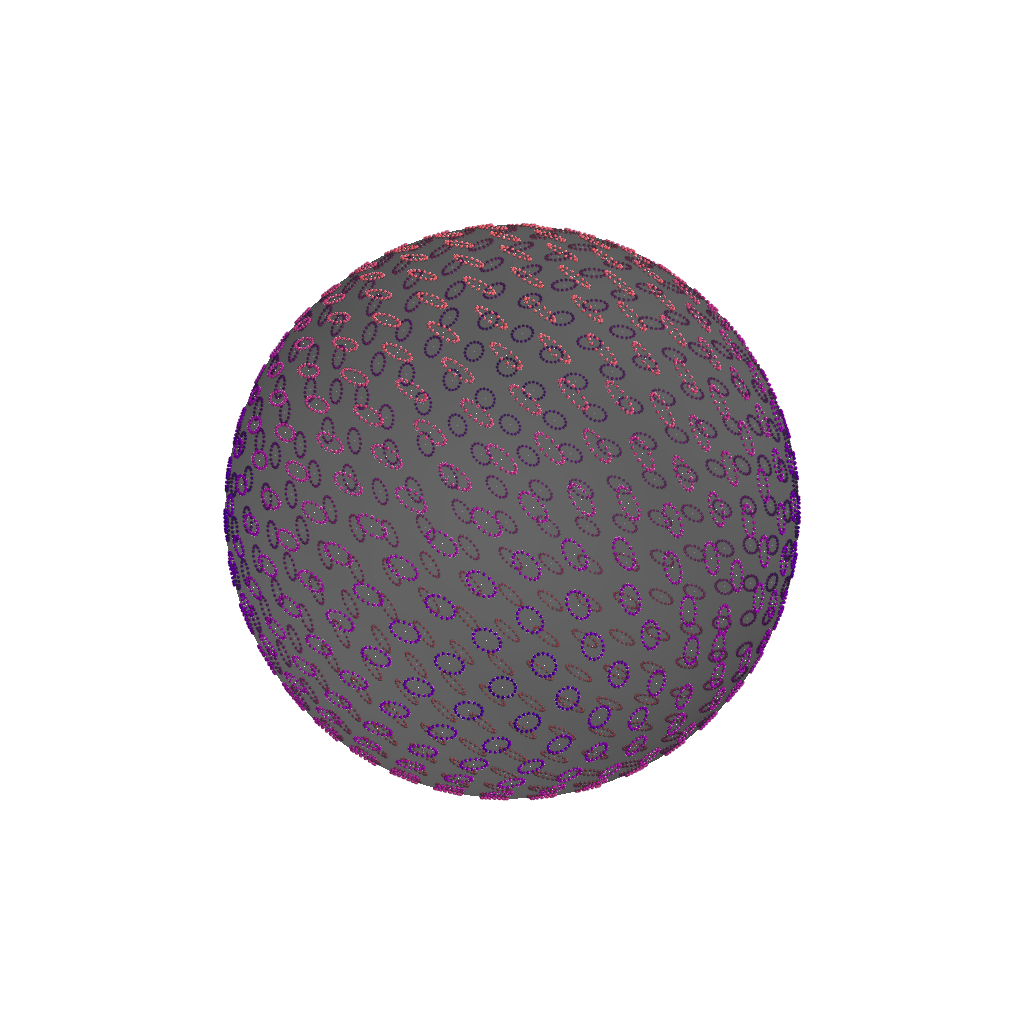
This animation visualizes in 3D the effect of gravitational waves from an equatorially-symmetric, continuous source (e.g., an asymmetric neutron star, or a nonprecessing compact binary at it very early moments of inspiral) emitting in the primary \(\ell=\pm m=2\) angular mode of radiation.
The source (not shown) is placed at the center of a semi-transparent black sphere representing the sky infinitely far away from the source. On the sphere, there are distributed a number of rings of freely falling particles, which serve to illustrate the effect of the gravitational waves as a function of inclination and azimuthal angle around the source. The effect of the wave is visible in the stretching-squeezing of the rings, and in their color, which is proportional to the amount of deformation: brighter colors indicate larger deformations, while darker colors indicate the ring is not being deformed. (Note that the appearent shape of the rings in the animation is a function of both the GW and 3D perspective; the color is uniquely a function of the GW.)
As mentioned above, points at the poles receive circularly polarized gravitational waves, points at the equator receive linearly polarized waves, and intermediate points receive waves with varying degrees of ellipticity as a function of the inclination (polar angle). Additionally a pattern in time emerges in the azimuthal rotation of the nuls of the GW (darker patches that move around the equator of the sphere), revealing that the azimuthal phase of the waves carry the quadrupolar imprint of the source such that and advancement in time is equivalent to an azimuthal rotation.
-
This content is released under the CC-BY-SA-4.0 license, (c) Max Isi 2023. ↩

